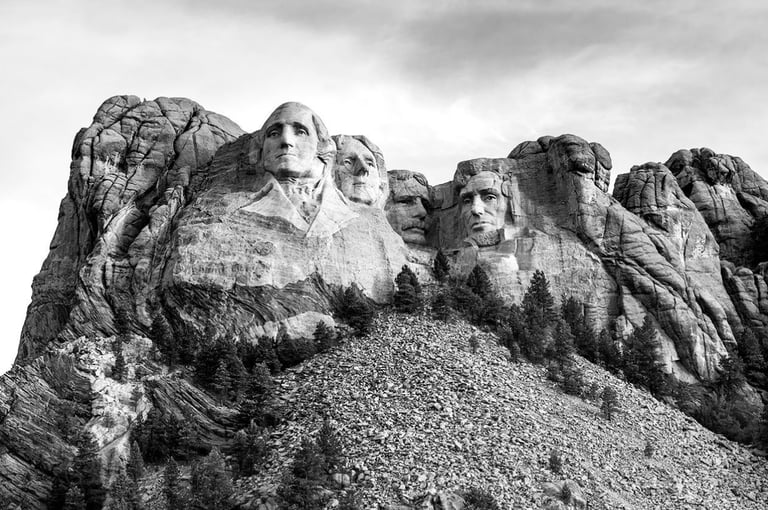The Mount Rushmore of Creative Nonfiction
When I started writing THE COLORS WE BLEED FOR, I’d never really dabbled much in writing nonfiction. Maybe the odd article or essay here and there, but not really. I really like creative nonfiction as a genre but had not really taken time to sit down and think about who did the most to blaze the trail before me. I whittled it down to four, in no particular order. They are Truman Capote, Hunter S. Thompson, A.E. Hotchner, and John Berendt.
By Adam Faraca, who is probably not currently on the Mount Rushmore of Anything
7/27/20253 min read


I’m not really sure that anyone can appreciate the genius of Capote. Maybe Philip Seymour Hoffman could, but he’s dead. The man wrote Breakfast at Tiffany’s. He edited the shit out of Go Set a Watchman to transform it into To Kill a Mockingbird. He also wrote In Cold Blood, which may be the best nonfiction novel ever written. He did all of this as a dandy gay man at a time when homophobia was a social moray. It is amazing that he was able to produce such quality work and be true to himself when society scorned him.
Capote, like me, loved New York City and Key West. I can’t blame him. Both places bring out the literary excellence in the best authors. Like too many authors, drinking and drugs took him from the world entirely too soon. That didn’t stop him from chiseling his place onto the Mount Rushmore of Creative Nonfiction.
HST invented Gonzo journalism. His 1970 article on the Kentucky Derby was nothing short of revolutionary. That style of writing continues today, whether it is war correspondence or a music festival. Gonzo lives on, even if Hunter is gone-zo.
Hunter was sort of a hybrid author and journalist. He’s not somebody who can be compartmentalized. The Hell’s Angels accepted him. Nixon hated him. And being Gonzo is a form of memoir, we can remember him in his own words. For me, The Rum Diary and Fear and Loathing in Las Vegas is peak HST. It is so good and groundbreaking I am surprised there hasn’t been a significantly greater push to ban his books. I’m not a Gonzo journalist, but I sure as hell appreciate the style and effort that goes into that art form.
Hunter is also one of Key West’s most famous dead author former residents. It all goes back to Key West. He and Jimmy Buffett lived in the same apartment. Man, if those walls could talk. Maybe when I am older, I can research and compose a self-guided HST walking tour of the city. If anyone else wants to beat me to it, feel free.
A.E. Hotchner, aka Hotch, is one of the best-known Hemingway biographers. They were friends and Hotch is a character in his own work. Gonzo Hemingway. Ah, Hemingway. The most famous of Key West’s dead author former residents. The Venn Diagram between his fate, Hunter S. Thompson’s, and Capote’s has considerable overlap. By contrast, Hotch lived to be over 100.
Hotch wasn’t just Hemingway. He was the co-founder of Newman’s Own and did creative nonfiction with Paul Newman. Doris Day and Sophia Loren were among his subjects, too. He was also close friends with JD Salinger and another one of Key West’s famous dead author former residents, Tennessee Williams. Williams would also fit in nicely on the aforementioned Venn Diagram. Point is, Hotchner was able to capture the lives of some of the biggest names of the 20th century. The list speaks for itself.
Last but not least we have John Berendt. Like Capote, his genre can be described as Southern Gothic. Berendt wrote Midnight in the Garden of Good and Evil. If you are under age 45 or so, you would be forgiven for not appreciating the cultural impact of this. The book SOLD. It was among the best-selling books of all time. Clint Eastwood made it into a movie. The movie is pretty great for mid 90s noir, but the book is like a million times better. And it is all based on a true story, which Berendt himself was involved in. Savannah sounds awesome and a big reason why is the way Berendt describes it. It is kind of amazing how something that big and impactful has largely been forgotten or swept under the rug. Then again, Game of Thrones was huge and then proved to be equally mercurial. Maybe it is not a huge surprise at all.
That’s it. That’s the Mount Rushmore. If you limit it to just those four, you’d still have a hell of a reading list. There are plenty of other great nonfiction authors and writers. Marcus Aurelius is a great one. Winston Churchill wrote tons of tomes. The list goes on. But don’t take it from me, read.
